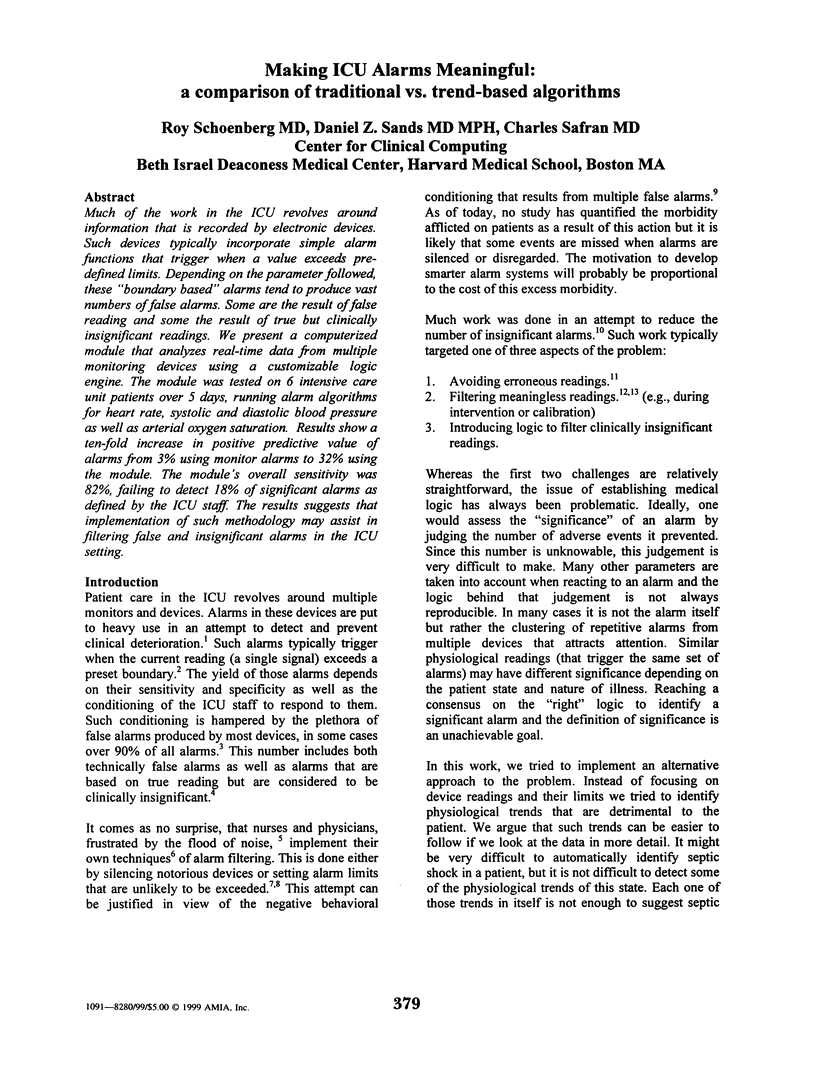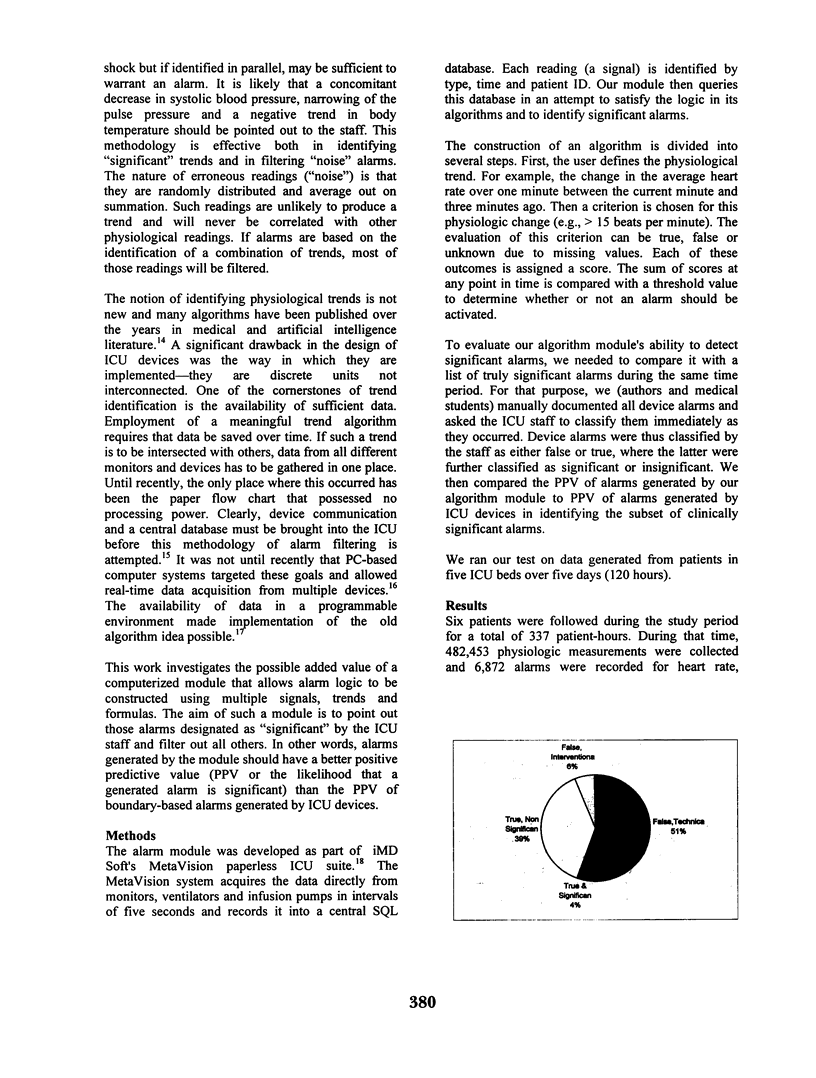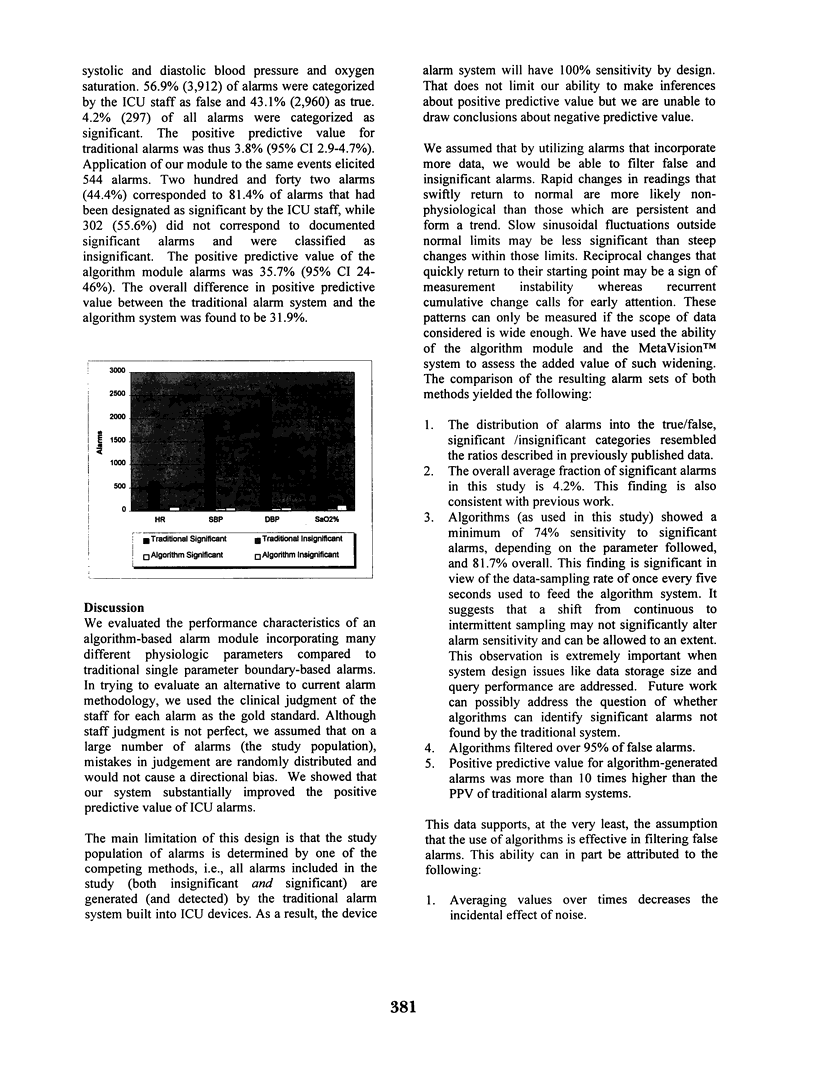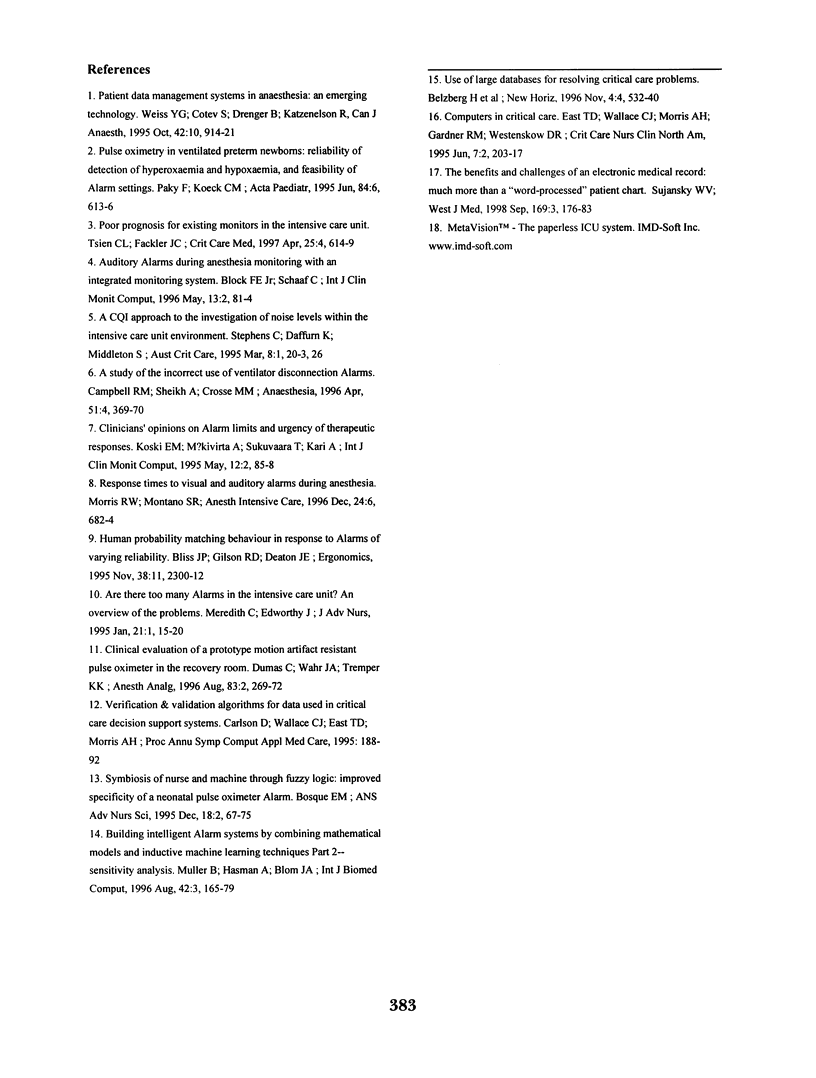Abstract
Much of the work in the ICU revolves around information that is recorded by electronic devices. Such devices typically incorporate simple alarm functions that trigger when a value exceeds predefined limits. Depending on the parameter followed, these "boundary based" alarms tend to produce vast numbers of false alarms. Some are the result of false reading and some the result of true but clinically insignificant readings. We present a computerized module that analyzes real-time data from multiple monitoring devices using a customizable logic engine. The module was tested on 6 intensive care unit patients over 5 days, running alarm algorithms for heart rate, systolic and diastolic blood pressure as well as arterial oxygen saturation. Results show a ten-fold increase in positive predictive value of alarms from 3% using monitor alarms to 32% using the module. The module's overall sensitivity was 82%, failing to detect 18% of significant alarms as defined by the ICU staff. The results suggests that implementation of such methodology may assist in filtering false and insignificant alarms in the ICU setting.
Full text
PDF




Selected References
These references are in PubMed. This may not be the complete list of references from this article.
- Belzberg H., Murray J., Shoemaker W. C., Cornwell E. E., Oder D., Guenon J., Velmahos G., Demetriades D. Use of large databases for resolving critical care problems. New Horiz. 1996 Nov;4(4):532–540. [PubMed] [Google Scholar]
- Bliss J. P., Gilson R. D., Deaton J. E. Human probability matching behaviour in response to alarms of varying reliability. Ergonomics. 1995 Nov;38(11):2300–2312. doi: 10.1080/00140139508925269. [DOI] [PubMed] [Google Scholar]
- Bosque E. M. Symbiosis of nurse and machine through fuzzy logic: improved specificity of a neonatal pulse oximeter alarm. ANS Adv Nurs Sci. 1995 Dec;18(2):67–75. doi: 10.1097/00012272-199512000-00008. [DOI] [PubMed] [Google Scholar]
- Campbell R. M., Sheikh A., Crosse M. M. A study of the incorrect use of ventilator disconnection alarms. Anaesthesia. 1996 Apr;51(4):369–370. doi: 10.1111/j.1365-2044.1996.tb07751.x. [DOI] [PubMed] [Google Scholar]
- Carlson D., Wallace C. J., East T. D., Morris A. H. Verification & validation algorithms for data used in critical care decision support systems. Proc Annu Symp Comput Appl Med Care. 1995:188–192. [PMC free article] [PubMed] [Google Scholar]
- Dumas C., Wahr J. A., Tremper K. K. Clinical evaluation of a prototype motion artifact resistant pulse oximeter in the recovery room. Anesth Analg. 1996 Aug;83(2):269–272. doi: 10.1097/00000539-199608000-00012. [DOI] [PubMed] [Google Scholar]
- East T. D., Wallace C. J., Morris A. H., Gardner R. M., Westenskow D. R. Computers in critical care. Crit Care Nurs Clin North Am. 1995 Jun;7(2):203–217. [PubMed] [Google Scholar]
- Meredith C., Edworthy J. Are there too many alarms in the intensive care unit? An overview of the problems. J Adv Nurs. 1995 Jan;21(1):15–20. doi: 10.1046/j.1365-2648.1995.21010015.x. [DOI] [PubMed] [Google Scholar]
- Morris R. W., Montano S. R. Response times to visual and auditory alarms during anaesthesia. Anaesth Intensive Care. 1996 Dec;24(6):682–684. doi: 10.1177/0310057X9602400609. [DOI] [PubMed] [Google Scholar]
- Müller B., Hasman A., Blom J. A. Building intelligent alarm systems by combining mathematical models and inductive machine learning techniques Part 2--sensitivity analysis. Int J Biomed Comput. 1996 Aug;42(3):165–179. doi: 10.1016/0020-7101(96)01210-x. [DOI] [PubMed] [Google Scholar]
- Paky F., Koeck C. M. Pulse oximetry in ventilated preterm newborns: reliability of detection of hyperoxaemia and hypoxaemia, and feasibility of alarm settings. Acta Paediatr. 1995 Jun;84(6):613–616. doi: 10.1111/j.1651-2227.1995.tb13709.x. [DOI] [PubMed] [Google Scholar]
- Stephens C., Daffurn K., Middleton S. A CQI approach to the investigation of noise levels within the intensive care unit environment. Aust Crit Care. 1995 Mar;8(1):20-3, 26. doi: 10.1016/s1036-7314(95)70220-x. [DOI] [PubMed] [Google Scholar]
- Tsien C. L., Fackler J. C. Poor prognosis for existing monitors in the intensive care unit. Crit Care Med. 1997 Apr;25(4):614–619. doi: 10.1097/00003246-199704000-00010. [DOI] [PubMed] [Google Scholar]
- Weiss Y. G., Cotev S., Drenger B., Katzenelson R. Patient data management systems in anaesthesia: an emerging technology. Can J Anaesth. 1995 Oct;42(10):914–921. doi: 10.1007/BF03011040. [DOI] [PubMed] [Google Scholar]


